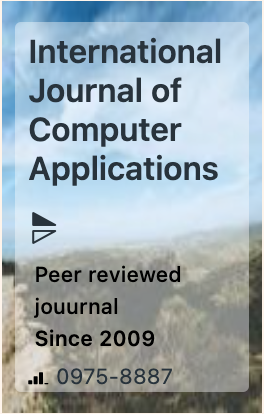The week's pick
Random Articles
Reseach Article
Breaking Barriers: Passwordless Authentication as the Future of Security
| International Journal of Computer Applications |
| Foundation of Computer Science (FCS), NY, USA |
| Volume 186 - Number 60 |
| Year of Publication: 2025 |
| Authors: Abhishek Prasad |
 10.5120/ijca2025924353
10.5120/ijca2025924353
|
Abhishek Prasad . Breaking Barriers: Passwordless Authentication as the Future of Security. International Journal of Computer Applications. 186, 60 ( Jan 2025), 29-35. DOI=10.5120/ijca2025924353
Abstract
In today’s scenario, software applications are facing new challenges while using password authentication for providing access to accounts. It can be easily understood and appreciated that while passwords have been existing for decades, they have become highly vulnerable to security attacks leading to data breaches. With the huge advancement in Artificial Intelligence, there has been a tremendous increase in sophisticated tools used by cybercriminals to gain unauthorized access. Therefore, there is a growing demand for passwordless technologies that can provide a highly secure and efficient way for authentication. This study explores detailed information on various passwordless authentication technologies and analyzes their benefits and drawbacks. Additionally, it attempts to make a comparison between these technologies based on different criteria. Passwordless authentication is commonly based on public-key cryptography, which uses a cryptographic key pair with a public and private key. The public key is used by authenticating services to authenticate users using the private key stored on the user's device secured behind a non-knowledge based authentication factor.
References
- Biggio, B., Akhtar, Z., Fumera, G., Marcialis, G.L., Roli, F.: Security evaluation of biometric authentication systems under real spoofing attacks. IET Biometrics 1(1), 11–24 (2012).
- Enis Ulqinaku, Hala Assal, AbdelRahman Abdou, Sonia Chiasson, and Srdjan Capkun. 2021. Is Real-Time Phishing Eliminated With FIDO? Social Engineering Downgrade Attacks Against FIDO Protocols. In USENIX Security Symposium (SSYM ’21). USENIX, Virtual Conference, 3811–3828.
- Heidari, H., & Chalechale, A. (2022). Biometric authentication using a deep learning approach based on different level fusion of finger knuckle print and fingernail. Expert Systems with Applications, 191. https://doi.org/10.1016/j.eswa.2021.116278.
- Syed Zulkarnain Syed Idrus, Estelle Cherrier, Christophe Rosenberger, Jean-Jacques Schwartzmann. A Review on Authentication Methods. Australian Journal of Basic and Applied Sciences, 2013, 7 (5), pp.95-107.
- V. Parmar, H. A. Sanghvi, R. H. Patel and A. S. Pandya, A Comprehensive Study on Passwordless Authentication, 2022 International Conference on Sustainable Computing and Data Communication Systems (ICSCDS), 2022, pp. 1266–1275, doi: 10.1109/ ICSCDS53736.2022.9760934.
- N. Singh, A. Agrawal, R. Khan, Voice biometric: A technology for voice based authentication, Advanced Science, Engineering and Medicine 10 (7-8) (2018) 754–759.
- Auth0 Passwordless Authentication with Magic Links, https://auth0.com/docs/authenticate/passwordless/authentication-methods/email-magic-link, Accessed on: Apr. 28, 2024, [Online].
- Okta Fingerprint Biometrics documentation: https://www.okta.com/identity-101/fingerprint-biometrics-definition-how-secure-it-is, Accessed on: Mar. 15, 2024, [Online].
- 1Kosmos Biometric Authentication documentation: https://www.1kosmos.com/biometric-authentication/fingerprint-authentication, Accessed on: Mar. 15, 2024, [Online].
- Wikipedia Passwordless Authentication, https://en.wikipedia.org/wiki/Passwordless_authentication, Accessed on: Feb 15, 2024, [Online].
- Securemetric FIDO Authentication documentation: https://www.securemetric.com/2019/05/17/pros-and-cons-of-fido-authentication, Accessed on: Feb. 22, 2024, [Online].
- Microsoft FIDO2 Authentication documentation: https://www.microsoft.com/en-us/security/business/security-101/what-is-fido2, Accessed on: Apr. 15, 2024, [Online].
- TechTarget Decentralized Identity documentation: https://www.techtarget.com/whatis/definition/decentralized-identity, Accessed on: May 1, 2024, [Online].
- Yubico Certificate Based Authentication documentation: https://www.yubico.com/resources/glossary/what-is-certificate-based-authentication, Accessed on: Mar. 15, 2024, [Online].
Index Terms
Keywords

